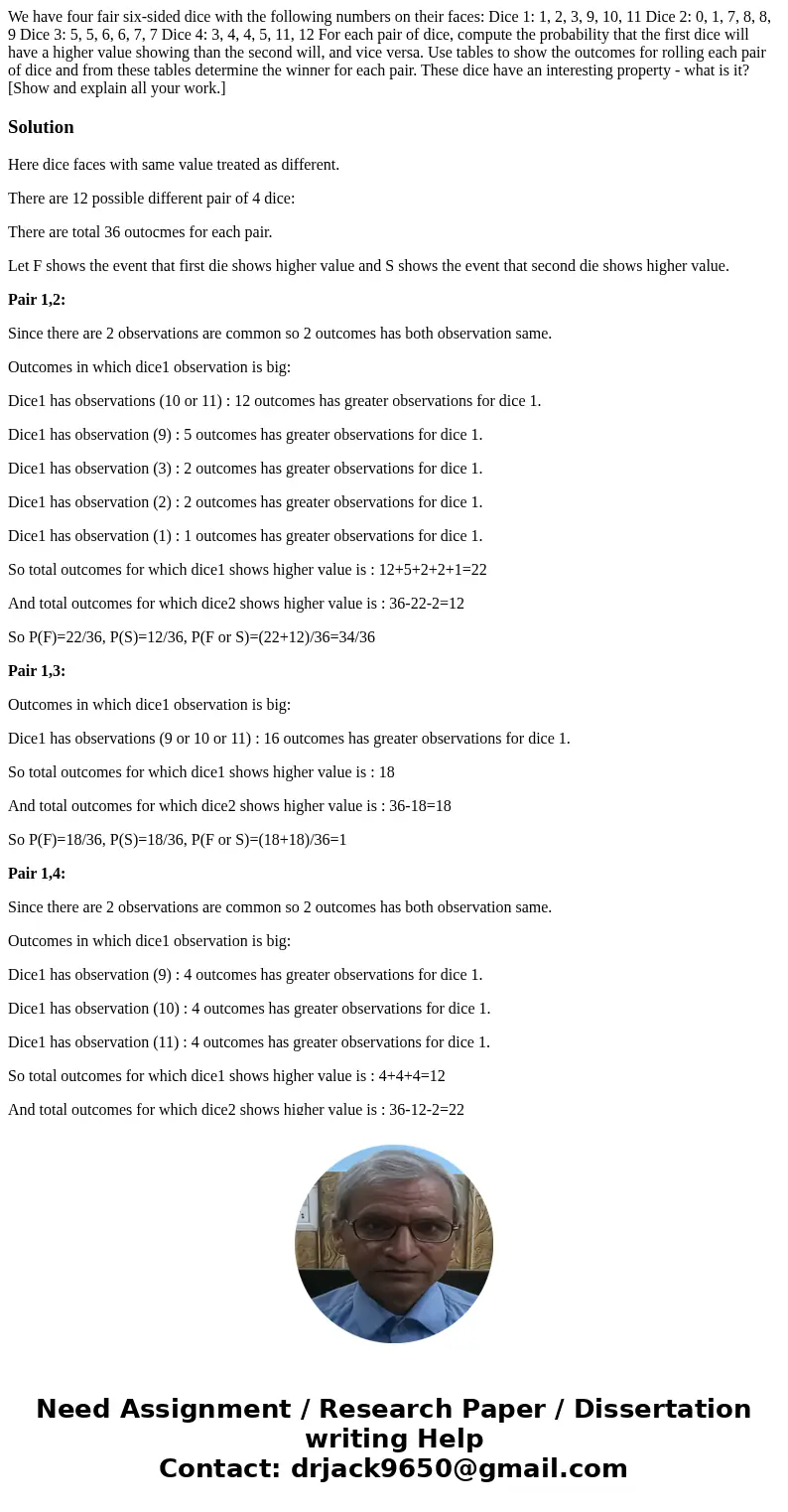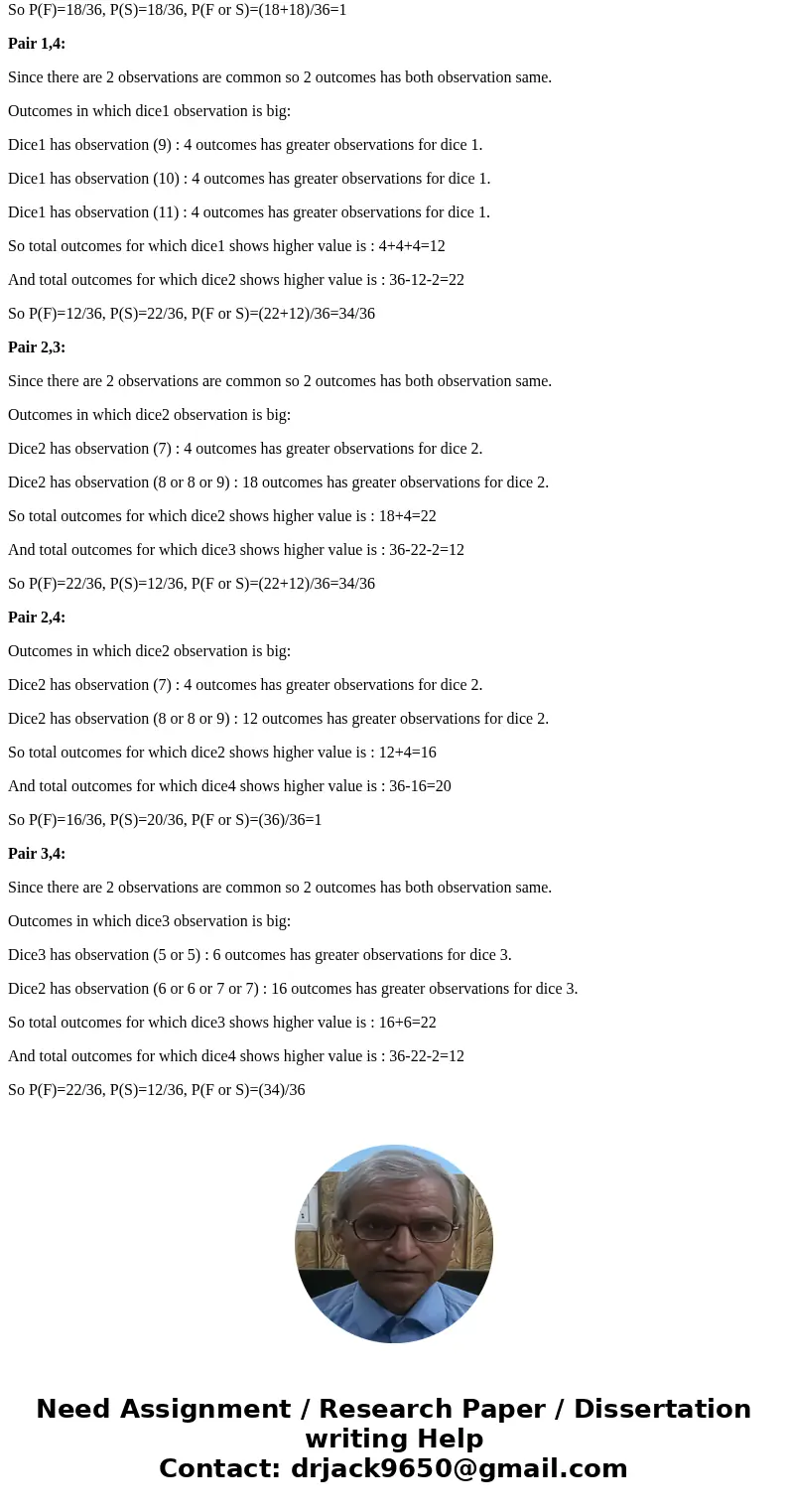We have four fair sixsided dice with the following numbers o
We have four fair six-sided dice with the following numbers on their faces: Dice 1: 1, 2, 3, 9, 10, 11 Dice 2: 0, 1, 7, 8, 8, 9 Dice 3: 5, 5, 6, 6, 7, 7 Dice 4: 3, 4, 4, 5, 11, 12 For each pair of dice, compute the probability that the first dice will have a higher value showing than the second will, and vice versa. Use tables to show the outcomes for rolling each pair of dice and from these tables determine the winner for each pair. These dice have an interesting property - what is it? [Show and explain all your work.]
Solution
Here dice faces with same value treated as different.
There are 12 possible different pair of 4 dice:
There are total 36 outocmes for each pair.
Let F shows the event that first die shows higher value and S shows the event that second die shows higher value.
Pair 1,2:
Since there are 2 observations are common so 2 outcomes has both observation same.
Outcomes in which dice1 observation is big:
Dice1 has observations (10 or 11) : 12 outcomes has greater observations for dice 1.
Dice1 has observation (9) : 5 outcomes has greater observations for dice 1.
Dice1 has observation (3) : 2 outcomes has greater observations for dice 1.
Dice1 has observation (2) : 2 outcomes has greater observations for dice 1.
Dice1 has observation (1) : 1 outcomes has greater observations for dice 1.
So total outcomes for which dice1 shows higher value is : 12+5+2+2+1=22
And total outcomes for which dice2 shows higher value is : 36-22-2=12
So P(F)=22/36, P(S)=12/36, P(F or S)=(22+12)/36=34/36
Pair 1,3:
Outcomes in which dice1 observation is big:
Dice1 has observations (9 or 10 or 11) : 16 outcomes has greater observations for dice 1.
So total outcomes for which dice1 shows higher value is : 18
And total outcomes for which dice2 shows higher value is : 36-18=18
So P(F)=18/36, P(S)=18/36, P(F or S)=(18+18)/36=1
Pair 1,4:
Since there are 2 observations are common so 2 outcomes has both observation same.
Outcomes in which dice1 observation is big:
Dice1 has observation (9) : 4 outcomes has greater observations for dice 1.
Dice1 has observation (10) : 4 outcomes has greater observations for dice 1.
Dice1 has observation (11) : 4 outcomes has greater observations for dice 1.
So total outcomes for which dice1 shows higher value is : 4+4+4=12
And total outcomes for which dice2 shows higher value is : 36-12-2=22
So P(F)=12/36, P(S)=22/36, P(F or S)=(22+12)/36=34/36
Pair 2,3:
Since there are 2 observations are common so 2 outcomes has both observation same.
Outcomes in which dice2 observation is big:
Dice2 has observation (7) : 4 outcomes has greater observations for dice 2.
Dice2 has observation (8 or 8 or 9) : 18 outcomes has greater observations for dice 2.
So total outcomes for which dice2 shows higher value is : 18+4=22
And total outcomes for which dice3 shows higher value is : 36-22-2=12
So P(F)=22/36, P(S)=12/36, P(F or S)=(22+12)/36=34/36
Pair 2,4:
Outcomes in which dice2 observation is big:
Dice2 has observation (7) : 4 outcomes has greater observations for dice 2.
Dice2 has observation (8 or 8 or 9) : 12 outcomes has greater observations for dice 2.
So total outcomes for which dice2 shows higher value is : 12+4=16
And total outcomes for which dice4 shows higher value is : 36-16=20
So P(F)=16/36, P(S)=20/36, P(F or S)=(36)/36=1
Pair 3,4:
Since there are 2 observations are common so 2 outcomes has both observation same.
Outcomes in which dice3 observation is big:
Dice3 has observation (5 or 5) : 6 outcomes has greater observations for dice 3.
Dice2 has observation (6 or 6 or 7 or 7) : 16 outcomes has greater observations for dice 3.
So total outcomes for which dice3 shows higher value is : 16+6=22
And total outcomes for which dice4 shows higher value is : 36-22-2=12
So P(F)=22/36, P(S)=12/36, P(F or S)=(34)/36


 Homework Sourse
Homework Sourse